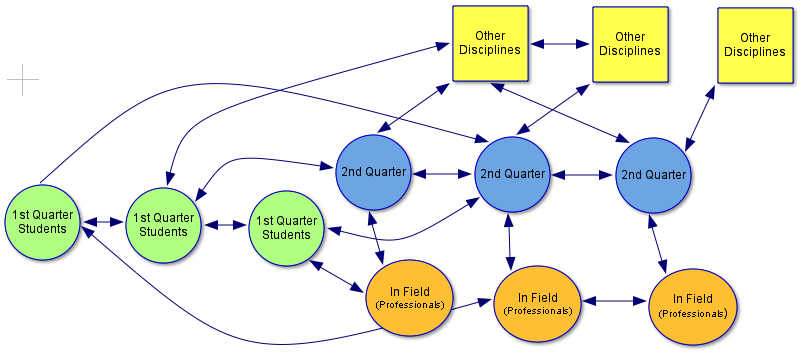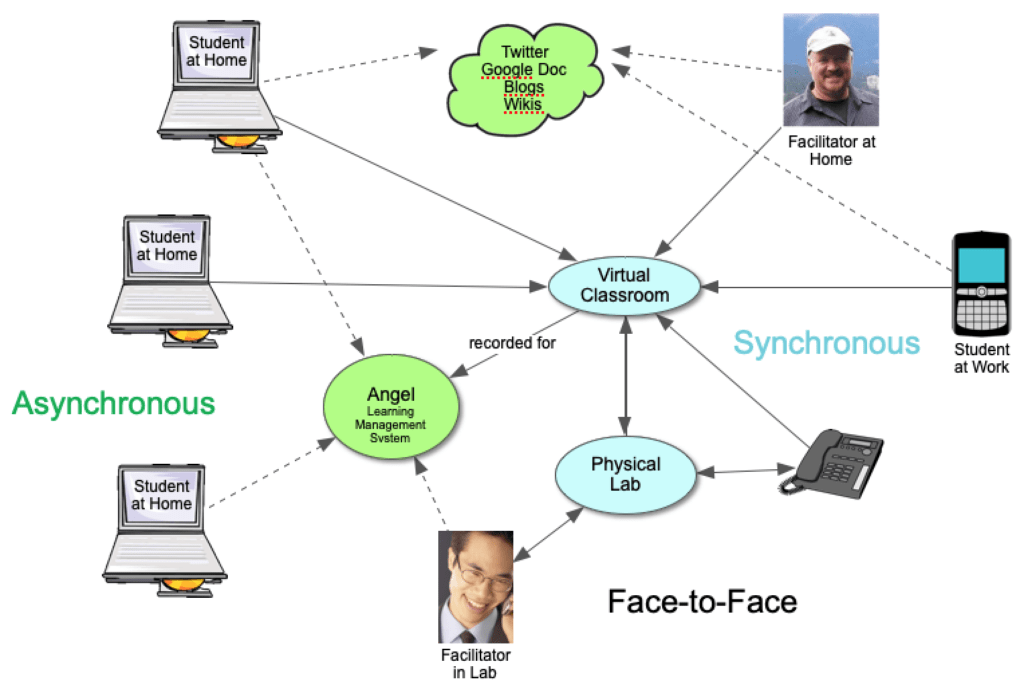The situation here is familiar: circumstances demand that we change how we deliver teaching and learning. We need to employ different teaching modalities, and we need to quickly prepare students for that. Notice I didn’t say “new” modalities. We are in a situation, and we will be here for a while, where we are bringing students and teachers online who have never been in an online class. The initial results are predictably bad: it takes skill, knowledge, and experience to teach online, as well as to learn online, and most of the population is not prepared. There are a number of “quick fixes” out there, but Zoom is not an online class or a replacement for one. Thinking that any one tool or even a combination of tools is a replacement for a classroom is the result of thinking of education purely in transactional terms. Real learning takes place in community, an engaged, connected community – a webinar does not replace this. So what do we do?
The Connectivist Classroom
The good news is that we have solved similar problems before. Back in 2008, I was approached by a Health Information Management instructor who had some problems to solve: the teachers were spending has much time teaching the technology of learning as they were their subjects; the students needed more technical skills; the students also needed to learn how to manage rapid changes in technology. This is similar to where we are now except most teachers and admins do not see the problem this way – they still see it as a “how do we deliver instruction” question rather than a change management problem. Additionally, we had the added problem that most of our community college students were already working in health care with erratic schedules. We did not want to exclude students because they have to work.
The Design
Together, we wrote a syllabus and course outline, Health Information Management 101. This course was a credit/no credit, two unit, student success course where we taught the students all of the technology they would need to be successful in the HIM program: their learning management system, web 2.0 tools, and Second Life (it was used on campus). The idea was to get all of the technology, formation of learning networks, and information access all in one class. This lets the teachers use the the technology to facilitate the course without having to teach the technology to the students. We hoped that this would be rolled out campus-wide one day, not just in the HIM department. The course design was based what we saw coming out of Connectivism, a new learning theory about how learning happens in networks, the book “The Starfish and the Spider” (a book about leaderless organizations), and the 23 Things project that introduced new technologies to librarians each week. I later came to understand the”leaderless classroom” more fully in Open Pedagogy.
It is important to stress here: even though there is a lot of technology in this class, it is about people and the connections they make, not the tools.
The idea was that we would design the course around connecting students with second year students, students who had graduated and were now in the field, and facilitators for the course. How were they all connected? The course introduced students to blogs, wikis, Twitter, and what was then called “Web 2.0” cloud-based applications that allowed for online communication, collaboration, and sharing.
We did not use all of these tools: we introduced many of them and let the students self-select which tools and platforms they wanted to work with and they tended to congregate around their shared preferences. The list of the tools changed from quarter to quarter, and sometimes week-to-week.
The “Classroom”
Remember, like today, we had to deal with people teaching and learning from different sites based on family and work needs. We decided to use a physical lab, a virtual classroom, and an LMS. The physical lab had a computer with a camera and microphone that was connected to the virtual room. The virtual room was Elluminate (an ancestor of Zoom). There were speakers in the lab so those in the lab could hear questions and comments in the the virtual class. Students could log into the virtual classroom with a laptop, microphone, and camera or they could dial in on the phone. Sometimes the physical lab’s microphone was the lab’s telephone.
Students could:
- Come to the physical classroom (the lab)
- Dial in on a phone
- Participate in the virtual class via Elluminate
- Go through the learning management system (Angel), do assignments there and link to recordings of the virtual classroom
The class was very successful, and by that I mean that we succeeded in creating and supporting a community of learners and practitioners that extended far beyond the classroom. One of my favorite moments in the class, one that told me we had it set up just right was when I was with a few students in the physical lab. A student in the lab had a problem, I could not get to that student yet as I was helping another, and I said I would be right there. Then a disembodied voice from the virtual class called the student by name and said “I know how to figure that out” and she proceeded to talk the other student through the problem using the camera as her “eyes” and the speaker in the classroom as her voice.
So What About The Future?
How does this help us now? There are a lot of alternative models out there that can support teaching and learning that do not require instructors and students to endanger their health. Technology is not the answer at all, but it can facilitate the community needed to make authentic education possible. There was nothing really revolutionary about what we did at Tacoma Community College. There were already people doing courses like this. In fact, the early Connectivist MOOCs with Siemens and Downes, and Cormier’s Rhizomtic Education: Community as Curriculum, right on up to the ideas around Open Pedagogy, all point to answers on how to teach and learn in a time of pandemic, or any crisis. We are actually in a multilayered crisis of health, social justice, and access to education. The fact that universities are so focused on tuition and football right now points to the failure of the traditional models. Classes with multimodal delivery, student-directed work, flexible schedules and geography are long over due.







